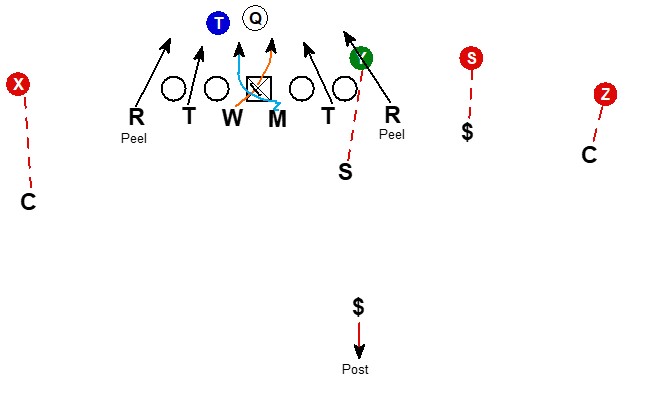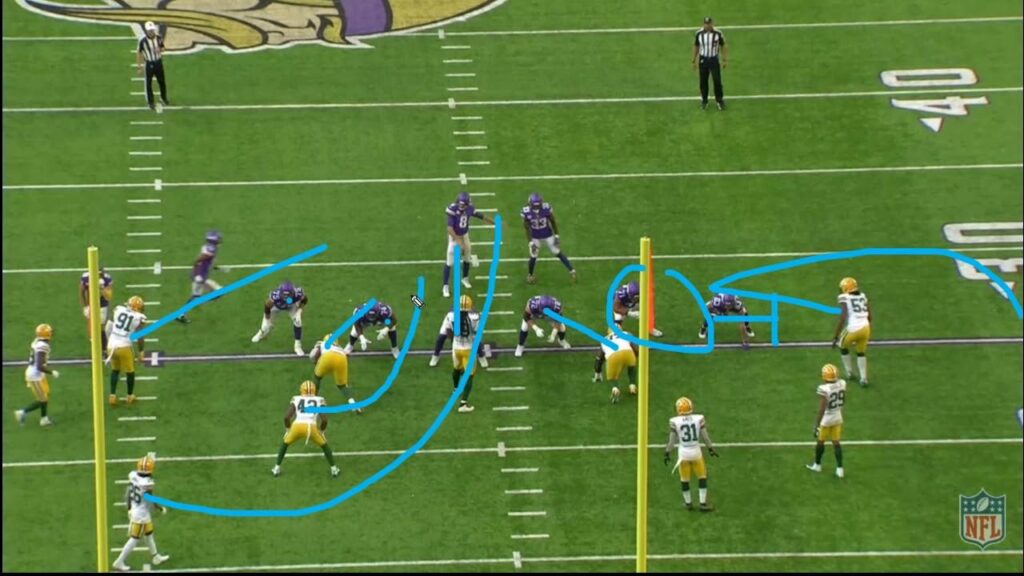Living under a rock might be the only excuse for not knowing that the Green Bay Packers have secured the services of Jeff Hafley as their new defensive coordinator. With his arrival, the Packers are poised to adopt a more aggressive, physical, and innovative defensive approach.
During his introductory press conference, Hafley expressed his eagerness to introduce innovative defensive strategies to Green Bay’s playbook. Notably, he highlighted the use of double A-gap pressure looks as a distinctive play design. In the subsequent analysis, I will delve into the potential benefits and impact of integrating an increased number of these double A-gap pressure looks under Hafley’s leadership for the Packers.
What is a double a gap pressure look?

In a double A-gap pressure look, the defensive formation takes on a single-high safety alignment, deploying six defenders directly in the face of the offensive line. The crux of this strategy lies in the positioning of two defenders, lined up at the gap between the center and the guards, commonly referred to as the A-gap.
The versatility of the double A-gap pressure look opens the door for the Packers to employ a myriad of defensive concepts. Particularly effective in third-and-long situations, this formation presents a deceptive front for the offense. From the quarterback’s perspective, it gives the illusion of an impending max blitz, inducing uncertainty and pressure. However, the beauty lies in the defense’s flexibility within this seemingly aggressive posture. The Packers, operating from the double A-gap pressure look, can seamlessly transition between max blitz, zone pressure, max coverage, or the implementation of simulated pressures.
Against the Minnesota Vikings in 2021, Green Bay executed a concept featuring a rush from two interior defensive linemen, while Preston Smith attacked from the edge. Adding to the pressure, both linebackers and Darnell Savage blitzed through the A gap from both sides. Although the play resulted in a touchdown for the Vikings, it highlighted a well-designed defensive concept that effectively attacked from multiple angles.

The implementation of the double A-gap pressure look addresses a longstanding concern – Green Bay’s vulnerability against the run. Throughout the Matt LaFleur era, the Packers have grappled with their run defense, consistently ranking in the bottom 10 in DVOA against the run. However, with the adoption of this aggressive defensive formation, Green Bay gains the advantage of keeping one extra player in the box.
The Packers boast a roster equipped to excel within the double A-gap pressure look. With players like Kenny Clark, Karl Brooks, and Devonte Wyatt anchoring the interior, Green Bay possesses a robust inside trio capable of disrupting offensive lines and penetrating A-gaps with authority. The versatility of players like Lukas Van Ness and Rashan Gary further amplifies the effectiveness of this defensive formation. Not only do they offer proficiency on the outside, but they also possess the agility and instincts to transition seamlessly to inside roles when tasked with attacking the quarterback through the A-gap. Additionally, the versatility extends to Quay Walker, whose ability to rush the passer from various angles adds another dimension to the Packers’ defensive arsenal.
One of the advantages of deploying the double A-gap pressure look lies in its ability to leave cornerbacks in one-on-one matchups with opposing receivers. Fortunately for the Packers, their defensive backfield is well-equipped to thrive in such situations. With cornerbacks like Jaire Alexander, Carrington Valentine, and Eric Stokes, Green Bay possesses a trio of physical, press corners. Their strengths lie in man-to-man coverage rather than zone defense.
The utilization of the double A-gap pressure look is just one facet of what could be a multi-dimensional approach. Regardless of the specific tactics employed, the Packers possess a foundation that positions them for success. With key personnel capable of executing various defensive strategies, Green Bay has the potential to ascend to a top-10 defense. The upcoming free agency and draft periods will undoubtedly play a pivotal role in shaping the team’s defensive game plan.

